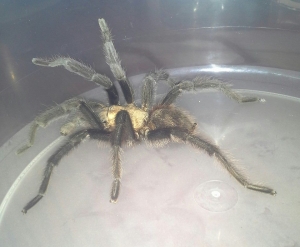
Contrary to popular belief, tarantulas are in fact inhabitants of certain areas of Colorado. Approximately 3-5 species of tarantula are present within the state. All of these species are dark brown to black in color, although some color banding may be present on their legs. Adult males are the most common of the tarantulas observed around the state as they migrate in search of females in the late summer and early fall. Males are smaller in size than females. The carapace of adult male tarantulas in Colorado ranges from 10-15 mm in length whereas females can be 20 mm in length. Wolf spiders are the most commonly mistaken for tarantulas of the spider species that are indigenous to the state.
Female tarantulas remain near their burrows and have shorter legs than males. Depending on the type of tarantula, the burrow is slightly larger than a quarter in diameter and covered with a veil of silk webbing at the entrance during the day to aid in deterring predators. Burrows can extend to a depth of approximately one foot with a side chamber at the end of the burrow. Females emerge at dusk to ambush prey that comes within a few inches of her burrow. Eggs are laid in June on a hammock made of silk and then covered in an additional layer of silk. While eggs remain in the burrow for a majority of their 50-60 day incubation, mother tarantulas are known to carry the eggs to the surface to warm them before returning them to her burrow. Spiderlings establish themselves around the burrow of their mother to begin with and expand their burrows within the following years.
Females are typically considered mature at an age of 9-12 years and males at 7-10 years. Remaining near their burrow, females have been known to live for many years beyond the point in which they reach maturity. Females molt after young have left the burrow in later July and beginning of August. Both male and female tarantulas maintain a burrow until the males reach their final molt in which they abandon the burrow to begin their migration in search of females. It is during this final molt that males develop the notably longer legs and become fully mature. Migration in southeastern Colorado sees great numbers of male tarantulas crossing highways and streets at dusk. Depending on the species location, migrating males are commonly seen migrating as early as August and as late as October. Migrating males rarely live beyond November in their natural habitat due to the cold weather; however, collected samples kept in captivity have been known to survive for several months.
Tarantulas of Colorado do not typically pose a health threat to humans. Their bite/venom, although capable of breaking skin is not known for causing serious medical complications in people. Primary defense of Colorado tarantulas is like that of other North American species and involved the use of their barbed body hairs which when rubbed from the abdomen of the tarantula onto a threatening person or animal will sting, creating an intense itching. The barbed hairs are also capable of causing injury to the eyes of would be attackers. Predators of tarantulas include coyotes, birds and lizards as well as certain predatory hunting wasps. In recent years, tarantulas have been increasing their range, moving further north and have been confirmed in areas south of Colorado Springs.